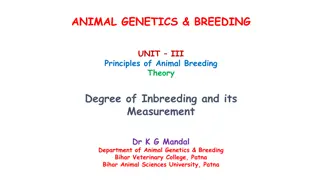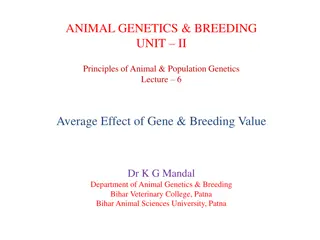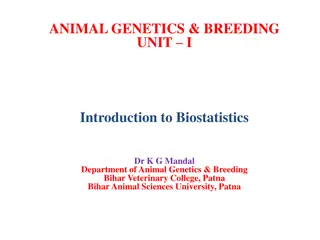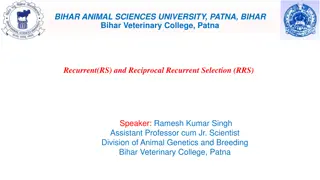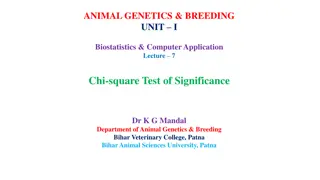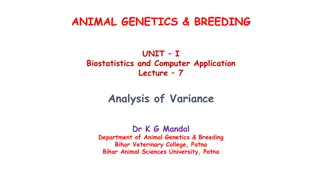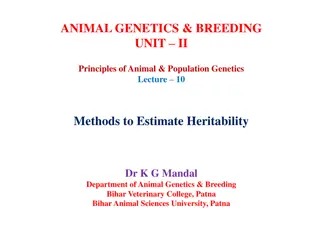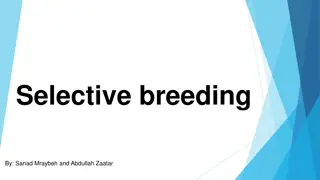Design of Experiment in Animal Genetics & Breeding: Principles and Methods
Biostatistics and computer applications play a key role in the design of experiments in animal genetics and breeding. Proper allotment of treatments to experimental units is crucial to study treatment effects accurately. Designing experiments helps in maximizing information from available resources, understanding treatment effects, making comparisons between treatments, and ensuring precise statistical analysis. Key considerations include study objectives, available experimental materials, traits under study, treatments for comparison, and required precision. Principles involve clarity in study objectives, variability among units, precision needed, simplicity in design, and clear comparisons among treatment effects. Methods to enhance experiment efficiency include randomization in treatment allotment, replication, use of local control, and considering auxiliary characters.
Download Presentation

Please find below an Image/Link to download the presentation.
The content on the website is provided AS IS for your information and personal use only. It may not be sold, licensed, or shared on other websites without obtaining consent from the author.If you encounter any issues during the download, it is possible that the publisher has removed the file from their server.
You are allowed to download the files provided on this website for personal or commercial use, subject to the condition that they are used lawfully. All files are the property of their respective owners.
The content on the website is provided AS IS for your information and personal use only. It may not be sold, licensed, or shared on other websites without obtaining consent from the author.
E N D
Presentation Transcript
ANIMAL GENETICS & BREEDING UNIT - I Biostatistics and Computer Application Lecture 6 Design of Experiment Dr K G Mandal Department of Animal Genetics & Breeding Bihar Veterinary College, Patna Bihar Animal Sciences University, Patna
Design of Experiment Design of Experiment: Proper allotment of treatment to the available experimental units. Treatment: It is the factor whose effect is to be studied. Example: Application of drugs, feeds, conditions, methods, etc. Experimental units: The subjects or individuals upon which an experiment is conducted. Example: Laboratory animals, primates, cattle, buffalo, sheep, goat, poultry, plant, a plot of land, etc.
Necessity of designing an experiment: 1. To get maximum information from the available resources. 2.To know the effect of treatment on units and to make comparison between treatments. 3. To know whether the difference between the effect of two treatments is significant or not. 4. A well designed experiment has a well defined method of statistical analysis of data. experimental
6. An ill- designed experiment is not likely to give proper estimates of parameters and comparisons between treatments with desired precision even if the method of data analysis is very good. 7. The design of experiment is essential to get all the important treatment effects to be compared independently.
Important considerations: 1. Objectives of the study 2. Types of experimental materials available 3. Characters to be studied 4. Treatments to be undertaken for comparison 5. Precision required
Principles of designing an experiment: 1. Objective of the experiment, Variability in the experimental units, Precision required and comparison to be made among various treatment effects must be very clear to the experimenter. 4. The design shall be least complicated. 3. When new treatments are under investigation, a tested treatment shall be kept as a control. 4. Statistical analysis of data should be easy as far as possible.
Methods to increase the efficiency of experiment: 1. Randomization in the allotment of the experimental units. treatment to 2. Replication under each treatment. 3. By using local control (also known as blocking). Grouping of experimental units is made to make them homogeneous under each group. 4. Use of auxiliary character, if any.
1. Randomization: Randomization is a process employed to avoid biasness in the allotment of treatments to the experimental units. Control F1 F2 F3 Total Kids 5 5 5 5 20 Methods of randomization: i) Lottery system ii) Using the table of random numbers
2. Replication: It is the number of times the effect of treatment is measured. In other words, it is the number of observations made under each treatment. Example: No. of treatments T1, T2, T3, .Tt No. of obs. under each treatment n1, n2, n3, ..nt Then, no, of replication under the treatments T1, T2, T3, ..Tt will be n1, n2, n3, .nt respectively.
Use of Replication: i) For proper estimation of error component of variance. ii) To reduce the magnitude of standard error, thereby to make the design of experiment efficient and precise. iii) To decide the (replication) to be recorded under each treatment. iv) To decide the number treatments to be tested with the available experimental units. number of observation
i. To provide proper estimation of error component of variance. Only one observation under each treatment cannot provide the estimation of error. Each observation is the sum of the: effect of treatment effect of experimental unit effect of uncontrolled extraneous factor (error)
Influence of factors on lactation milk yield of the cow: Y1 = C1 + F1 + E1 Y2 = C2 + F2 + E2 Where, Y1 & Y2 = LMY of cow 1 & 2 respectively. C1 & C2 = Genetic effect of cow no. 1 & 2 respectively. F1 & F2 = effect of Feed 1 & 2 or treatments. E1 & E2 = Extraneous factor or error. (Y1 Y2) = (C1 C2) + (F1 - F2) + (E1 E2) There is no possibility of getting separate estimation of error.
ii) To reduce the magnitude of standard error (SE): Why? Effect of two or more treatments are required to be compared. Reduction in SE helps in detecting even smaller difference between two treatment means. To increase the efficiency of experiment i.e., to make the design of experiment precise. But how?
?12 ?1 SE of mean (x1) for treatment 1 = ?22 ?2 SE of mean (x2) for treatment 2 = SE of difference of two treatment means = ?2(1 1 ?1 + ?2) SE reduces with the increase of n1 & n2. Comparison of means by making difference: ( x1 x2 ) Where, S12 and S22 are the variance of sample 1 & 2 respectively.
iii) To decide the number of observation to be recorded under each treatment. To make the Design of experiment precise, for safer side, the minimum error degrees of freedom (df) should be at least 10. following equation = t(n 1) In CRD, the minimum error df will be decided by the Where, t = no. of treatment n = no. of replication per treatment.
Suppose 4 treatments / feeds are to be compared. If error df is 10, then no. of replication per treatment will be: 10 = 4(n 1) = 4n 4 or, 4n = 14 or, n = 14/4 = 3.5 4 That is number of replication per treatment = 4 Thus, total no. of experimental units required, N = nxt = 4x4 = 16
iv) To decide the number treatments to be tested with the available experimental units. In case of CRD, the error df = t(n 1) that is t(n -1) = 10 Total number of experimental units, N = nxt Where, t = no. of treatment & n = no. of replication per treatment
If total no. animals available, N = 20 Then, no. treatments will be decided by allotting at least 1 df or 2 animals per treatment. Hence, N = nxt or, 20 = 2xt or, t = 20/2 = 10 3. Local control or blocking: Grouping of experimental units is done to reduce the variability among the experimental units within the block.
Example of Local Control or Blocking Feed 1 Rhode Island Red New Hampshire White Plymouth Rock Cornish 5 Feed 2 5 Feed 3 5 Feed 4 5 5 Breed 5 5 5 5 5 5 5 5 5 5 5
Types of Design: 1. Completely Randomized Designed (CRD) 2. Randomized Block Design (RBD) 3. Latin Square Design (LSD)
Completely Randomized design (CRD) CRD is used when experimental units form a homogenous group. Example: i) Day old chicks of the same breed. ii) Very young Laboratory animals mice, rats, etc. iii) In agriculture, several plot of land in the same field. Allotment of treatment to the experimental units: Allotment takes place completely at random.
Example: Let there are N units and t treatments, N will be multiple of t . Then, N = nt Each treatment is allotted with n units at random. Total no. of experimental units required: IT is decided by error degrees of freedom. For precise test of significance in CRD the minimum error df should be at least 10.
In CRD, the error df = t(n 1) = 10 Q. Five (5) treatments are to be compared. How many number of experimental units will be required? Ans. t = 5, error df = 10 Then, 5(n 1) = 10, or, 5n 5 = 10 5n = 10 + 5 = 15 or, n = 15/5 = 3 Hence, total no. of exp. Units, N = nt = 3x5 = 15
Degrees of freedom: DF for treatment = t 1 Error DF = t(n 1) Total DF = (tn 1) = N 1 Analysis of Variance (ANOVA) Source of variation Betn Treatment Error Total Degrees of Freedom t 1 t(n 1) nt - 1
Number of Feed (Treatment) = 4 Total number of animal = 20 Source of variation Degrees of freedom Between Feed (treatment) 3 Between animal within treatment (Error) Total 4(5 1) = 4x4 = 16 20 1 = 19 or, 3 + 16 = 19
Advantage of CRD: 1. Easy to design 2. Analysis of data is simple & straight forward. 3. Statistical analysis do not become complicated if some of the experimental units fail to provide information.
Disadvantage of CRD: 1. The design requires homogeneous set of experimental units. 2. If experimental units are not homogenous, the error component will be large and this will make the treatment comparison less efficient.
Randomized Block Design This is an improvement over CRD. This is applied when experimental units are heterogeneous. All the experimental units are grouped into different homogeneous blocks according to variability. Number of experimental units within each block are the multiple of treatments.
Allotment of treatment is not completely at random like CRD but the allotment is completely at random homogeneous block. within the
Example: To study the effect of certain feed on body weight gain of day old chicks. Chicks are from different breeds say New Hampshire, Plymouth Rock, Cornish & Sussex. Total number of chicks = 80 Number of chicks in each breed = 20 Number of male = 10 Number of female = 10 Number of Block = 4
Degrees of freedom: In RBD, each treatment is applied to one experimental unit within each block. Number of replication of each treatment is equal to number of blocks. Number of treatment = t Number of Block = b
Source of variation DF Between Blocks Between treatment t - 1 Error (Block x Tr.) (b 1)(t 1) Total b - 1 bt - 1
Precise test of significance: The number of blocks and number of treatments will be such that the error degrees of freedom should be at lest 10. Example: Number of treatment, t = 4 Number of block = b 10 = (b 1)x(4 -1) = (b 1)x3 or, 10 = 3b 3 or, 3b = 13 or, b = 13/3 = 4.2 or 4 Total no. of experimental units = 4x4 = 16
Merit of RBD: Most frequently used design. It is easy to design with one local control. Statistical analysis of data is simple but little bit tricky than CRD. It eliminates one assignable causes of variation among experimental units by using local control or blocking. The error DF in RBD is lesser than that of CRD due to removal of DF for blocks.
Demerit of RBD: 1. Whenthe number of treatments to be compared is large then it becomes difficult to get large blocks of homogeneous experimental units. 2. The analysis of data becomes difficult if one or more than one observation in RBD is missing. Under such condition it will be necessary to remove or omit that block.






